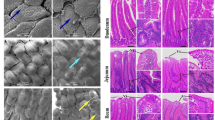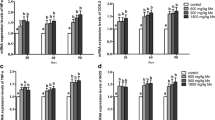Abstract
The present study aimed to find whether low doses of mixed mycotoxins would affect egg quality in laying hens, and to explore the oxidative stress induced liver damage through endoplasmic reticulum during summer stress. A total of 96 Jinghong laying hens, 36 wks of age, were divided into four treatments, with eight repetitions per treatment and three hens per repetition. All the hens were raised in summer (average temperature: 31.3 ± 0.5℃; average humidity: 85.5 ± 0.2%) for 28d. One treatment was fed a basal diet as control (CON), and the other three treatments were fed the same diets containing 3.0 mg/kg deoxynivalenol (DON), 0.5 mg/kg T-2 toxin (T-2), and 1.5 mg/kg DON + 0.25 mg/kg T-2 toxin (Mix). Albumen height and Haugh unit were decreased (P < 0.05) in the Mix group on day 14 and 28. The activity of total antioxidant capacity, glutathione peroxidase, catalase, and superoxide dismutase were decreased (P < 0.05) in the DON, T-2, and Mix groups. The alkaline phosphatase level in DON, T-2, and Mix groups was significantly increased (P < 0.05). The level of interleukin-1β, interferon-γ, and tumor necrosis factor-α in the Mix group were higher (P < 0.05) than CON, DON, and T-2 groups. Mix group upregulated the mRNA expressions of protein kinase RNA-like ER kinase, activating transcription factor4, IL-1β, nuclear factor-κ-gene binding, and nuclear respiratory factor 2 in the liver (P < 0.05). The results showed that low doses of DON and T-2 toxin could cause oxidative stress in the liver, but DON and T-2 toxin have a cumulative effect on virulence, which can reduce egg quality and cause endoplasmic reticulum stress in the liver.




Similar content being viewed by others
References
Ashiq S (2015) Natural occurrence of mycotoxins in food and feed: Pakistan Perspective. Compr Rev Food Sci Food Saf 14:159–175
Ben Salem I, Prola A, Boussabbeh M et al (2016) Activation of ER stress and apoptosis by α- and β-zearalenol in HCT116 cells, protective role of Quercetin. Neurotoxicology 53:334–342
Bertero A, Moretti A, Spicer LJ et al (2018) Fusarium molds and mycotoxins: potential species-specific effects. Toxins 10:244
Chen SS, Li YH, Lin MF (2017) Chronic exposure to the fusarium mycotoxin deoxynivalenol: impact on performance, immune organ, and intestinal integrity of slow-growing chickens. Toxins 9:334
Dazuk V, Boiago MM, Rolim G et al (2020) Laying hens fed mycotoxin-contaminated feed produced by Fusarium fungi (T-2 toxin and fumonisin B1) and Saccharomyces cerevisiae lysate: impacts on poultry health, productive efficiency, and egg quality. Microb Pathog 149:104517
Escrivá L, Font G, Manyes L (2015) In vivo toxicity studies of fusarium mycotoxins in the last decade: a review. Food Chem Toxicol 78:185–206
Habrowska-Górczyńska DE, Kowalska K, Urbanek KA et al (2019) Deoxynivalenol modulates the viability, ROS Production and apoptosis in prostate Cancer cells. Toxins (Basel) 11(5):265
Hetz C, Papa FR (2018) The unfolded protein response and cell Fate Control. Mol Cell 69(2):169–181
Huang Y, Zhao C, Kong Y et al (2021) Elucidation of the mechanism of NEFA-induced PERK-eIF2α signaling pathway regulation of lipid metabolism in bovine hepatocytes. J Steroid Biochem Mol Biol 211:105893
Ibrahim D, Goshu G, Esatu W et al (2019) Dual-purpose production of genetically different chicken crossbreeds in Ethiopia. 1. Parent stocks’ feed intake, body weight, and reproductive performance. Poult Sci 98(8):3119–3129
Jia H, Liu N, Zhang Y et al (2021) 3-Acetyldeoxynivalenol induces cell death through endoplasmic reticulum stress in mouse liver. Environ Pollut 286:117238
Kim C, Kim B (2018) Anti-cancer Natural products and their bioactive compounds inducing ER stress-mediated apoptosis: a review. Nutrients 10:1021
Kobayashi M, Li L, Iwamoto N et al (2009) The antioxidant defense system Keap1-Nrf2 comprises a multiple sensing mechanism for responding to a wide range of chemical compounds. Mol Cell Biol 29(2):493–502
Lee HJ, Ryu D (2017) Worldwide occurrence of mycotoxins in cereals and cereal-derived food products: Public Health Perspectives of Their Co-occurrence. J Agric Food Chem 65:7034-7051.
Li Y, Schwabe RF, DeVries-Seimon T et al (2005) Free cholesterol-loaded macrophages are an abundant source of tumor necrosis factor-alpha and interleukin-6: model of NF-kappaB- and map kinase-dependent inflammation in advanced atherosclerosis. J Biol Chem 280(23):21763–21772
Livak KJ, Schmittgen TD (2001) Analysis of relative gene expression data using real-time quantitative PCR and the 2(-Delta Delta C(T)) method. Methods 25:402–408
Mishra S, Srivastava S, Dewangan J et al (2020) Global occurrence of deoxynivalenol in food commodities and exposure risk assessment in humans in the last decade: a survey. Crit Rev Food Sci Nutr 60(8):1346–1374
Nayakwadi SR, Ramu Kumar Sharma A, Kumar Gupta V et al (2020) Toxicopathological studies on the effects of T-2 mycotoxin and their interaction in juvenile goats. PLoS ONE 15, e0229463
Safaa HM, Serrano MP, Valencia DG et al (2008) Productive performance and egg quality of brown egg-laying hens in the late phase of production as influenced by level and source of calcium in the diet. Poult Sci 87(10):2043–2051
Urra H, Dufey E, Lisbona F et al (2013) When ER stress reaches a dead end. Biochim Biophys Acta 1833(12):3507–3517
Wang M, Kaufman RJ (2016) Protein misfolding in the endoplasmic reticulum as a conduit to human disease. Nature 529(7586):326–335
Wang X, Xu W, Fan M et al (2016) Deoxynivalenol induces apoptosis in PC12 cells via the mitochondrial pathway. Environ Toxicol Pharmacol 43:193–202
Wang J, Jin Y, Wu S et al (2019) Deoxynivalenol induces oxidative stress, inflammatory response and apoptosis in bovine mammary epithelial cells. J Anim Physiol Anim Nutr (Berl) 103(6):1663–1674
Wickramasuriya SS, Macelline SP, Kim E et al (2020) Physiological impact on layer chickens fed corn distiller’s dried grains with solubles naturally contaminated with deoxynivalenol. Asian-Australas J Anim Sci 33(2):313–322
Wu QH, Wang X, Yang W et al (2014) Oxidative stress-mediated cytotoxicity and metabolism of T-2 toxin and deoxynivalenol in animals and humans: an update. Arch Toxicol 88(7):1309–1326
Wu J, Yang C, Yang M et al (2022) The role of ER stress and ATP/AMPK in oxidative stress meditated hepatotoxicity induced by citrinin. Ecotoxicol Environ Saf 237:113531
Yang JY, Zhang YF, Li YX et al (2018) l-arginine protects against oxidative damage induced by T-2 toxin in mouse leydig cells. J Biochem Mol Toxicol 232(10), e22209
Yang X, Zhang X, Zhang J et al (2019) Spermatogenesis disorder caused by T-2 toxin is associated with germ cell apoptosis mediated by oxidative stress. Environ Pollut 251:372–379
Yang J, Guo W, Wang J et al (2020) T-2 Toxin-Induced oxidative stress leads to Imbalance of mitochondrial Fission and Fusion to Activate Cellular apoptosis in the Human Liver 7702 cell line. Toxins (Basel) 12(1):43
Ying C, Hong W, Nianhui Z et al (2019) Nontoxic concentrations of OTA aggravate DON-induced intestinal barrier dysfunction in IPEC-J2 cells via activation of NF-κB signaling pathway. Toxicol Lett, 114–124
Zhang Y, Han J, Zhu CC et al (2016) Exposure to HT-2 toxin causes oxidative stress induced apoptosis/autophagy in porcine oocytes. Sci Rep 6:33904
Author information
Authors and Affiliations
Corresponding author
Ethics declarations
Conflict of interest
The authors declare that they have no competing financial interests.
Financial support statement
This study was financially supported by the National Natural Science Foundation of China (32160799), the Key R&D program of Jiangxi Province (20203BBF63021), the Jiangxi Provincial Natural Science Foundation (20224ACB205010 and 20202BABL216042).
Additional information
Publisher’s Note
Springer Nature remains neutral with regard to jurisdictional claims in published maps and institutional affiliations.
Rights and permissions
Springer Nature or its licensor (e.g. a society or other partner) holds exclusive rights to this article under a publishing agreement with the author(s) or other rightsholder(s); author self-archiving of the accepted manuscript version of this article is solely governed by the terms of such publishing agreement and applicable law.
About this article
Cite this article
Guo, H., Wan, H., Lou, W. et al. Deoxynivalenol and T-2 toxin cause liver damage and egg quality degradation through endoplasmic reticulum stress in summer laying hens. Int J Biometeorol (2024). https://doi.org/10.1007/s00484-024-02674-w
Received:
Revised:
Accepted:
Published:
DOI: https://doi.org/10.1007/s00484-024-02674-w




